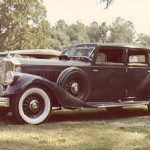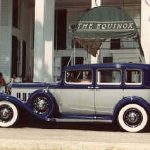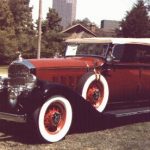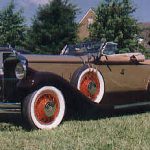- Home
- About Us
- Join/Renew
- Member Benefits
- Member Pages
- Log In
- Help
- Museum Store

As the decade of the Roaring Twenties came to a close and the great depression lurked just around the corner, Pierce-Arrow made one of the biggest changes to it’s product line in it’s history. For 1929, Pierce-Arrow introduced a completely new line of cars. The six cylinder engine was retired and a new straight-eight was developed. The new Pierce-Arrows were long, low, and a great success, setting a new sales record of almost 10,000 cars in 1929.
The new Pierce-Arrow was offered in two models, the 133 and the 143, with the model designation denoting the wheelbase. The 133 was offered in 12 body styles ranging in price from $2875 for the roadster to $3325 for the Tonneau Cowl Phaeton. The 143 was available in seven body styles priced from $3750 for the 7-passenger touring to $8200 for the French Brougham.

Under the new, longer hood was Pierce-Arrow’s new straight-eight engine. Unlike the 1928 Series 81 and 36 cars that had a cast steel block bolted to an aluminum crankcase, the new nine main bearing eight was cast with a single crankcase and cylinder block assembly. The engine used an L-Head arrangement for the valves (unlike the Series 36’s T-Head) , and used Stromberg UU-2 carburetor, unlike earlier models that used a carburetor of Pierce-Arrow manufacture. The bore and stroke were 3 1/2″ by 4 3/4″, adding up to 366 cubic inches. With a 5:1 compression ratio and engine speed of 3200 rpm, the new straight eight developed 125 hp. Pierce-Arrow advertising claimed a top speed of 85 mph. The new straight-eight was continued, with modifications, through 1938. In 1933, the engine was changed to use hydraulic valve lifters, a Pierce-Arrow innovation, and also to use a down draft carburetor.

In 1932, the straight-eight was augmented with the addition of two new twelve-cylinder engines. The Model 53 used the smaller 398 cid engine; the Models 51 & 52 used the larger 429 cid engine. The 1932 models features more flowing body lines than the previous years and also brought a few new features, including ride-control that allowed the shock absorbers to be adjusted from the instrument panel and Startix, an automatic starting device.
To publicize the new twelve, Pierce-Arrow arranged for the race driver, Ab Jenkins, to drive a Pierce-Arrow on the Bonneville Salt Flats. An unofficial, 24-hour run was done in 1932, with an average speed of 112.91 miles per hour. In 1933, Pierce-Arrow repeated the run, this time with AAA observing and conducting the run. This time, Jenkins drove 3000 miles in 25 1/2 hours, averaging 117 mph. This trial broke 66 official AAA speed records. In 1934, another run set a new worlds speed record of 127 mph for 24 hours. The virtues of the Pierce-Arrow twelve continued long after Pierce-Arrow ceased production. The basic engine, with some modifications, was made well into the 1970’s for use in Seagrave fire trucks.

The mechanical virtues of the Pierce-Arrow in the early thirties would be enough to secure Pierce-Arrow a page in automotive history. However, just as impressive as the eight and twelve cylinder engines was the Pierce Silver Arrow. Original built for the 1933 New York Automobile Show, the cars were also a hit at the 1933 Century of Progress Exposition in Chicago. The cars features streamlined styling that included an all-steel top, and side mounted spare tires concealed in compartments in the front fenders.
Many of the changes at Pierce-Arrow during the early thirties was a result of the influence of Pierce-Arrow’s major stockholder, the Studebaker Corporation. In 1928, Studebaker bought $5.7 million in Pierce-Arrow stock. Studebaker was one of the major automobile companies in America and the acquisition of Pierce-Arrow put Studebaker in the number four position, behind General Motors, Ford, and Chrysler. Albert Erskine, the president of Studebaker became the chairman of the board of Pierce-Arrow, while Myron Forbes remained on as president of Pierce-Arrow. In addition to much needed cash, Pierce-Arrow also gained an increased dealer network, as Pierce-Arrows were sold through Studebaker dealerships. The engineering efforts remained, for the most part, separate, although Pierce-Arrow blocks were cast in the Studebaker foundry in South Bend. During these years, Studebaker spent a considerable amount of money on improvements to the Pierce-Arrow factory in Buffalo. Unfortunately, the optimism of the 1929 sales did not continue forward and sales at Pierce-Arrow dropped. Studebaker eventually declared bankruptcy in 1933 and sold Pierce-Arrow to a group of Buffalo businessmen for $1 million. Arthur Chanter, a former Studebaker man, became president of Pierce-Arrow, once again an independent company.
